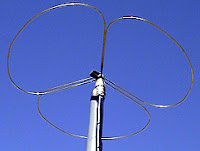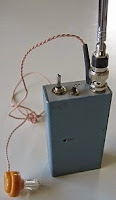Posts Tagged ‘2m’
 KL7 Tropo?
KL7 Tropo?
 |
| courtesy: http://www.nrlmry.navy.mil/ |
Like our unprecedented early hot and stable weather pattern over the West coast, this path is fairly rare and has never really been explored ... this one appears to be forming a stable path towards Alaska. The predicted conditions can be viewed on Bill Hepburn's World Wide Tropospheric Ducting Prediction page. Select the Eastern North Pacific from the 'Region' drop-down menu and see the map for Saturday.
Perhaps there are some KL7s near the water, or not too far inland and with a clear shot towards the southeast, that would be interested in running some possible tropo tests over the next few days if the path shapes up as predicted in the Bill Hepburn maps for the weekend. Not ever having explored this possible path before might yield some interesting results ... and who knows how far south into Puget Sound a tropo signal from the north might reach? Maybe it's time to find out. Of course, any stations between here and northern KL7 (Prince Rupert?... Juneau? ... Ketchikan?) might also be interested in trying a possible 2m path.
 Mizuho QRP SSB rigs
Mizuho QRP SSB rigs
I don’t think this company still exists.
At one time you could buy Mizuho single band SSB handhelds for many bands up to 2m including many HF bands. I owned the 2m 200mW pep version (MX2) and managed to work some decent SSB DX with mine mostly with a 1/2wave whip on the rig. The main issue was the poor battery life, so I tended to use an external 9.6V battery.
My rig was used in the main with a homebrew 2m-10m transverter and I worked all over the world on 10m with just the tiny Mizuho rig on the desk.
If I remember right I covered the CW and main SSB parts of 10m by having a couple of crystals in the transverter. Somewhere I still have the transverter, although it has not been used for years.
 Big wheel antenna
Big wheel antenna
 |
| Big Wheel for 2m |
A good 2m antenna for horizontal polarisation is the big wheel. Quite a few beacons use these as they require no rotator and a couple of these stacked give about 5dBd gain horizontally. So, these would be ideal for fixed station use. They would suit me well for UKAC 2m contests and general 2m SSB/CW use. I know that my 3 el, hand rotated, beam has about the same gain. One big wheel alone is better than a halo, but two suitably phased would be better than a small beam.
 Fredbox – 2m transceiver
Fredbox – 2m transceiver
Many years ago I designed and made the 2m AM Fredbox 2m AM transceiver. At the time it was the smallest 2m transceiver I’d ever seen or used. Several close copies were made. It worked some impressive DX including several 60 mile handheld contacts and one over 100 miles to Brittany from the South Devon coast. All these were with whip antennas on the rig and not beams. Most QSOs were with locals. The power was only 10mW AM. It was ideal for contacts around Cambridge where I lived at that time.
Some years ago, I rebuilt the transceiver and had some decent QSOs yet again.
As with the Sixbox, I would suggest the design is taken as a springboard for your own version. It is certainly ripe for further development.
 Fredbox derivatives
Fredbox derivatives
Since my original Fredbox 2m AM design, a number of derivatives have been designed and built around the world. This is what our hobby is all about. Although the original Fredbox worked well and its results surprised me, it was always ripe for further developments, which is healthy. My Sixbox was a 6m version and at some point, when fitter, I’d like to make a simple 10m AM version for local natters.
See https://sites.google.com/site/g3xbmqrp3/vuhf/fredbox for the original Fredbox. Click on the schematic to enlarge. Other derivative ideas are on my website www.g3xbm.co.uk. By the way, it got its name from Fred G8BWI who was a disabled local in the Cambridge area back in the 1970s. Fred was a regular contact and he could talk for hours and hours and hours and hours zzzzzzzzzzz. RIP Fred.
 Early days on 2m
Early days on 2m
 My first ever RX outings on 2m were with a derivative of the CQ2 super-regen RX circuit from Practical Wireless back in the late 1960s. The very first signal I ever heard on 2m was G3VEH/P on Caradon Hill in Cornwall. I was located at Kingsbridge in South Devon. I used a small crystal earpiece and a 19 inch whip. The same receiver was later adapted with the addition of an RF amplifier in my Fredbox AM transceiver. These were the days when AM was still king on 2m. The best DX contacts with the 10mW Fredbox were impressive.
My first ever RX outings on 2m were with a derivative of the CQ2 super-regen RX circuit from Practical Wireless back in the late 1960s. The very first signal I ever heard on 2m was G3VEH/P on Caradon Hill in Cornwall. I was located at Kingsbridge in South Devon. I used a small crystal earpiece and a 19 inch whip. The same receiver was later adapted with the addition of an RF amplifier in my Fredbox AM transceiver. These were the days when AM was still king on 2m. The best DX contacts with the 10mW Fredbox were impressive.
A few years ago, I rebuilt my Fredbox and had a few local QSOs on 2m AM. It still works well for something this small and simple. More details of the Fredbox are on my website. Follow the link above.
 Echolink Node?
Echolink Node?
Over here in G (or M or 2) land echolink nodes need to have permissions from the grown ups. So I’ve sought permission from Ofcom, with the help of the RSGB. I applied for an MB7 node, which means it is can be unattended. In order to do this I needed a minimum of 4 people who are key holders so the node can be shut down quickly. Sounds reasonable? Sounds a bit British to me. Belt and braces and some more belts just for luck.
The node will hopefully be on 2m and I have been told that if it gets granted then I could expect around 2w ERP. I don’t want to sound selfish but I have only heard 2m simplex used in this area for the local net and once in a blue moon Dent gets activated by a SOTA or WOTA chap(ess). VHF in general is scarcely used and its a shame. UKAC evenings and the normally quiet repeaters with their occasional skeds excepting mean that both 2m and 70cms are dead.
What can be done about it?
Making it appealing to use, perhaps? A bit of activity always helps.
Internet link may give some users an opportunity not only with existing amateurs but could make it appealing to those on the periphery of the hobby. Makers for example.
Anyway, let the waiting begin and we’ll see where we get to with Ofcom















